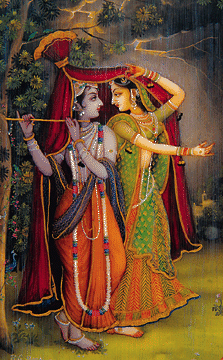return to Home Page
or move on to Goddess Sunna, next chronologically,
or use Her Cyclopedia Index
Sita, The-Furrow
SET*
[to Whom the twenty-second day of December, day 356, is dedicated]

return to Home Page
or move on to Goddess Sunna, next chronologically,
or use Her Cyclopedia Index
Sita, The-Furrow
SET*
[to Whom the twenty-second day of December, day 356, is dedicated]

Geography/Culture: Hindustani.
Description: Goddess of spring, earth and agriculture; Corn Mother; She is the Furrow that takes the seed; She is the Everlasting Field which brings forth bountiously; Germinator of seed; She Who is associated with fertility, abundance and prosperity; She Who is closely connected with husbandry; Matron of agriculturists.
In Her legend, as an incarnation of Laksmi, Good-Fortune, mortal Sita, The-Furrow, is associated with Spring, the season of Her birth. She is represented as of incomparable beauty and considered the embodiment of grace, charm, sexual reserve and conjugal fidelity.
To Whom Sacred: Cow (symbol of Earth as provider of all food); Gazelle (the animal by means of which Ravana accomplished the abduction of Sita thus fulfilling Her role as Laksmi's incarnation); doe (Her eyes are sometimes likened to those of a doe); a furrow ploughed in soil (especially for the planting of cereal seeds -- the ploughed furrow as the repository of seed was regarded as Earth's genitalia); vulva (symbol of the ploughed furrow as the repository of seed); fire, ordeal by fire, (Earth is also known as Agni's Womb in which the embryo of existence is formed, it is of Her essence -- which is why it could not harm Her mortal form); plough-share; the number 12 (symbol of the year -- in spring at the start of sowing season it was customary for the King or chieftan to plow twelve ritual furrows in the first field to ensure fertility and prosperity in the coming year); the colour red (Her garments, when Agni rose with Her from the the fire, were red); Garland that does not wither (which She was wearing them when She came out of the fire -- garlands which do no wither is one of the signs by which Deities may distinguished from mortals).
Iconography: Sita and Rama.
Male Associates: She appeared, fully formed, from a furrow ploughed by Janaka, King of Videha (who was also born without a progenitor), during the ritual ploughing at sowing time (or, some say, from the furrow he had ritually ploughed when performing a sacrifice to obtain offspring), She is therefore also called Daughter of Janaka. Consort Rama, Charming, the gentle, or Ramacandra, Rama-of-Moonlike-Beauty, culture hero and incarnation of Visnu. She was abducted by Ravana, Raksasa King of the island fortress Lanka. Twin sons, Kusa and Lava.
Ayonija, 1YONYJ*, Not-Womb-Born.
Ksetrasay-Patni, Queen-of-the-Soil, maybe a form of Her, or one of Her titles.
Maithili, {She-of-the-City-Maithila}, after the capitol city of Videha, the realm of King Janaka, Her foster father.
Geography/Culture: Hindustani.
Linguistic Note: sati is a feminine noun formed from the verbal root sat, real, true, good, virtuous. Such epithets were applied especially to a widow who on the death of her husband proved her devotion by being burned with him on his fueral pyre.
Male Associate: consort, Siva.
Notes:
Upon seeing Sita again {after Her abduction} Rama accused Her of unfaithfulness and repudiated Her. She protested.
"If my limbs were touched, it was by force, my lord; I did not desire it, fate brought about this offence. My heart, which is under my control, is ever attached to you. . . Tiger among men, by giving way to anger like a trivial man you have made womankind preferable. . . Build a pyre for me; destroyed by false accusations, I cannot live, the only possible thing for me to do is to enter the Oblation-bearer."
Standing before the pyre She invoked the flames:
"As my heart never wavered from Rama, so may Agni, witness of all people, protect me." So saying She walked into the blaze.
Agni, God of fire, then rose up with Sita, (shining like the sun at dawn), on his lap and led Her before Rama saying:
"Here is your Sita and there is no evil in Her. Neither in speech nor in mind, nor in thought nor in glance, has This Woman of exalted conduct transgressed against you".
Hearing which Rama replied he never doubted but had needed public proof.
They returned to Rama's homeland where he took up the throne in a reign of unprecedented prospertity and peace. However the people were unconvinced of Sita's fidelity and murmured among themselves. Rama therefore banished Her to the forest where She gave birth to twin sons, Kusa and Lava. These two entered the capitol at the age of fifteen and were recognised by Rama who then sent for Sita to demonstrate again Her loyalty.
Before a great assemblage of people She appealed to Her Mother Prthivi, Widely-Extended-One, -- She Who is the final arbiter when innocence or integrity is in doubt -- and the Earth Goddess responded by arising from the soil in human form seated on a golden throne, and by embracing Her Daughter-Self, and by descending with Her into Their elementary form.
Source: Stutley HDH; O'Flaherty HM; Ions IM; Larousse WM; New Larousse EM.